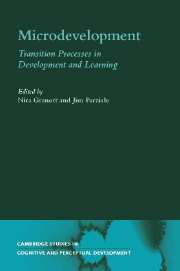Book contents
- Frontmatter
- Contents
- List of figures
- List of tables
- List of contributors
- Microdevelopment: A process-oriented perspective for studying development and learning
- Part I Variability
- Part II Transition mechanisms
- Part III Micro- and macrodevelopment
- 7 Interacting time scales in personality (and cognitive) development: Intentions, emotions, and emergent forms
- 8 How microdevelopment creates macrodevelopment: Reiterated sequences, backward transitions, and the Zone of Current Development
- 9 Macro- and microdevelopmental research: Assumptions, research strategies, constraints, and utilities
- Part IV Context
- Author index
- Subject index
- References
9 - Macro- and microdevelopmental research: Assumptions, research strategies, constraints, and utilities
Published online by Cambridge University Press: 22 September 2009
- Frontmatter
- Contents
- List of figures
- List of tables
- List of contributors
- Microdevelopment: A process-oriented perspective for studying development and learning
- Part I Variability
- Part II Transition mechanisms
- Part III Micro- and macrodevelopment
- 7 Interacting time scales in personality (and cognitive) development: Intentions, emotions, and emergent forms
- 8 How microdevelopment creates macrodevelopment: Reiterated sequences, backward transitions, and the Zone of Current Development
- 9 Macro- and microdevelopmental research: Assumptions, research strategies, constraints, and utilities
- Part IV Context
- Author index
- Subject index
- References
Summary
Introduction
Over the last half century, developmental research has undergone tremendous change. Our knowledge of how children develop in the physical, neurological, cognitive, and social domains has advanced greatly. In some areas, progress has been so extensive that old theories have been abandoned and textbooks completely rewritten (e.g., infant perceptual and cognitive development). Other advances are evident in the emergence of entire fields that did not even exist two or three decades ago (e.g., developmental neuroscience: Johnson, 1999; developmental connectionism: Elman, Bates, Johnson, Karmiloff-Smith, Parisi, & Plunkett, 1996). Still other, relatively “old” areas have moved in novel directions that have revealed new facts about how children develop (e.g., motor skills: Thelen, 1995; language: Markman, 1991; memory: Bruck & Ceci, 1999).
Theoretical approaches to developmental research have also changed dramatically in the past fifty years. For instance, in cognitive development research, radical behaviorism was replaced by Piagetian constructivism in the 1950s and 1960s, which itself was challenged by symbolic information processing theorists in the 1970s. The assumptions of symbolic information processing theories were later contested by connectionist theorists and domain-specificity theorists in the 1980s and 1990s. Nativist theories are also again in vogue after being marginalized for nearly a century. In addition, dynamic systems approaches derived from chaos theory in mathematics and thermodynamic research have been introduced to account for certain patterns of child development (Thelen & Smith, 1994; van Geert, 1991).
Information
- Type
- Chapter
- Information
- MicrodevelopmentTransition Processes in Development and Learning, pp. 243 - 266Publisher: Cambridge University PressPrint publication year: 2002
References
Accessibility standard: Unknown
Why this information is here
This section outlines the accessibility features of this content - including support for screen readers, full keyboard navigation and high-contrast display options. This may not be relevant for you.Accessibility Information
- 16
- Cited by
